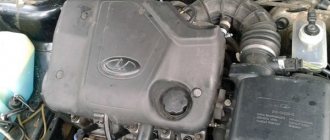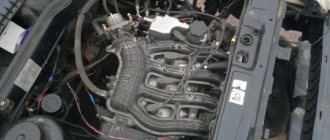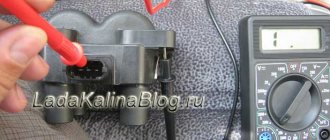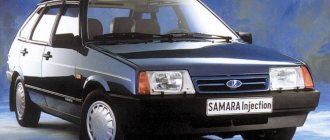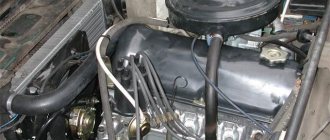“Fourteenth”, despite the fact that it has an outdated design, is still in demand by domestic drivers. Therefore, future owners of this car are interested in how much horsepower the VAZ 2114 has and which engine is best to get it with. Over its history, the car was produced with different types of power units of varying power. In this article we will tell you what engines this car was produced with, and also analyze their strengths and weaknesses, fuel consumption and acceleration.
8 valve engine 1.6
The 1.6-liter engine with 8 valves also began to be installed in 2003, that is, from the first years of production. The last such “four” rolled off the assembly line in 2013. Fans of the model are interested in how much horsepower the VAZ 2114 (8 valves) has with an engine of this size.
This power unit has a power of 89 horses . It is slightly more powerful than a 1.5 liter engine. But it is advisable to use AI-95 gasoline for it.
True, many owners fill in AI-92, which does not harm the car at all. The car is very economical. In the combined cycle, its fuel consumption is about 7.5 liters per hundred kilometers. And it accelerates to 100 km/h in 13 seconds. Since 2010, AvtoVAZ began installing an electronic gas pedal on this modification. But this innovation was not warmly received by all car enthusiasts. Fuel injection has also been improved in connection with new environmental standards. Fans of the model also have an ambivalent attitude towards this change.
Body geometry
Many owners of the 14th model, driving a car for many years, do not even suspect how important the correct body geometry can be. But, in reality, this is the most important factor on which the performance and driving characteristics of the car depend. Without knowing what the overall body geometry is, there will be no way to check it. In addition, it will be useful to know what affects the violation of geometry dimensions, in what cases it changes, etc.
Geometry and what it is
In the automotive industry, geometry is usually called the “integrity” of dimensions between the main points of the body, standardly installed by the manufacturer. This is the most perfect position of all elements. If any discrepancy is observed, the operation of the components and mechanisms will no longer move in the right direction, since they are attached directly to various body parts. Needless to say, this will have an extremely negative impact on security.
The word body geometry on hatchbacks usually means the following distances:
- Between certain points of doorways (diagonals, height and width);
- Between the points of the hood and engine compartment.
On sedans, these indicators are supplemented by the standard trunk dimensions for the VAZ 2114.
Experts call the most important distances between control points of body parts associated with components and mechanisms of the chassis system. For example, these are the distances between the spars or glasses.
The accuracy of geometric dimensions will have a positive effect on additional parameters that are no less important in terms of increasing the convenience of driving characteristics and their safety. How does a geometry violation occur?
Why does the body geometry change and how is the check carried out?
The causes of body damage are not always accidents. If the owner often drives on uneven roads and various kinds of obstacles periodically appear on his way, changes in the geometry of the car body can be expected soon.
Of no small importance, of course, is the degree of damage, which entails a change in size. The more a certain part is subjected to deformation, the more the geometry of the body as a whole changes.
Checking the conformity of the body to the geometric dimensions is a very important component, which the vehicle owner is not always able to carry out independently. The fact is that changes may not be immediately noticeable at first glance. The car body tends to deform gradually, without “signaling” about it.
16 valve engine 1.6 (SuperAuto)
Not everyone knows, but 2114 also has a special SuperAuto series. A small number of these cars were produced. They are distinguished by improved driving performance and dynamic characteristics.
Under the hood of this car there is a 1.6-liter engine with 16 valves. It produces a power of as much as 92 hp , which is quite good for this model. Combined with the light weight of the car, this made it much faster. The car accelerates to 100 km/h in 11.2 seconds.
AI-95 fuel is recommended for this engine. But some drivers use AI-92. For a hundred kilometers, such a car requires approximately 7.2 liters of gasoline.
Trunk Features
The features of the luggage compartments of various modifications of models 2113, 2114, 2115 include an acceptable level of capacity and the possibility of transforming the interior to increase useful volume.
The VAZ 2115 is distinguished by a convenient loading height and a larger trunk volume than the Lada 2115. Otherwise, the design of the cargo compartment is identical to other models.
Cars are equipped with a standard shelf; it is installed vertically and separates the luggage compartment and the interior. If necessary (for example, when transporting large cargo that requires folding the rear seats), this shelf and the vertical curtain can be removed.
On Lada 2113, 2114, 2115 cars, under the “floor” of the trunk there is a niche for storing a spare wheel and tools necessary for quickly repairing small faults that may arise along the way.
The VAZ 2115 is distinguished by a convenient loading height and a larger trunk volume than the Lada 2115. Otherwise, its design is identical to other models.
The VAZ 2113, 2114, 2115 models, which are modifications of the “eights”, “nines” and “ninety-nines”, respectively, have become more ergonomic, easy to use, and practical. The cars received spacious luggage compartments, which increased the amount of cargo transported. The presence of a number of shortcomings does not deter drivers: some inconveniences can be corrected on their own.
Cars of the VAZ 2113, 2114, 2115 family are popular not only in Russia, but also in the CIS countries. This is due to the wide distribution of these cars, their unpretentiousness, relative reliability, maintainability and cost. The machines have an acceptable loading niche capacity, which makes them convenient to use for solving everyday household problems or running a small business.
Fuel consumption
Hatchbacks of this model are known for their efficiency. They consume little fuel, both on the highway and in the city. We invite you to compare the gasoline consumption of the VAZ 2114 for modifications with different types of power plants.
| Engine | Highway consumption l/100 km | Mixed mode, l/100 km | Urban cycle, l/100 km |
| 1.5l, 8-valve | 5,7 | 7,3 | 10,0 |
| 1.6l, 8-valve | 6 | 7,5 | 10,3 |
| 1.6 l, 16 valve | 5,4 | 7,2 | 9,8 |
Improved aerodynamics
The VAZ 2114 car excels in aerodynamic characteristics thanks to its well-designed body lines, providing excellent streamlining. As a result of the change in appearance, the drag coefficient has decreased.
External aerodynamic improvements of the Lada2114Samara-2 also affected changes in the position of the air flow separation point. To do this, the designers had to change the angle of inclination of the most aerodynamically active front part of the car - the hood. The front fenders have also undergone changes.
Power plant of the VAZ 2114 car
As a result of the redistribution of the air flow, a smaller part of it is directed under the bottom, while the larger part is directed onto the hood and spreads over the body. These characteristics change the amount of total lift force, as a result of which the front and rear axles are unloaded. The even distribution of lift force allows the hatchback to behave in a balanced manner during high-speed driving.
Acceleration to 100 km/h
Thanks to the light weight of the body, with its modest power data, the car turned out to be quite nimble. Even with the weakest power unit, it accelerates to 100 km/h quite quickly. The table presents comparative acceleration data for cars with different types of engines.
| Engine | Acceleration to 100 km/h, s |
| 1.5l, 8-valve | 13,2 |
| 1.6l, 8-valve | 13 |
| 1.6 l, 16 valve | 11,2 |
Ilya Pimenov
— Questions about the legality of such tuning and the likelihood of passing inspection on this car are quite predictable. However, all modifications were made by an authorized technical center, and the craftsmen installed certified spare parts. This car has a special sports technical passport, and the pilot has a sports category according to the requirements of the RAF. As for the rest: the exterior and interior of the car are standard, the steering wheel and brakes work perfectly, the headlights shine as expected, exhaust gases are within normal limits... There is a first aid kit, a fire extinguisher and a warning triangle. Everything is absolutely legal. The maintenance ticket was not purchased.
VAZ-211340: Club-standard
Which engine is better?
Each of the engines of this car has its own disadvantages and advantages. Therefore, it is difficult to answer this question unambiguously.
The 1.5 liter engine has little power, but it is reliable and unpretentious. The power unit is not demanding on fuel quality. If the timing belt breaks, the valve does not bend. A common problem with such power units is belt slippage. If you don't take care of it, it can be damaged by the rollers. The 1.6-liter 8-valve engine slightly added power to the car. But at the same time, gasoline consumption has also increased. This engine is the most uneconomical among those installed on the VAZ 2114. At the same time, it is reliable and durable. In cars with an electronic gas pedal, according to some motorists, slower acceleration is possible. But perhaps this is due to driving style and other factors. The 16-valve 1.6-liter engine is considered the most progressive and powerful in the line. He gave the “fourteenth” a significant increase in power and excellent dynamics. At the same time, fuel consumption has also decreased. This engine needs good maintenance and better fuel. If the timing belt breaks, the valves may bend. This is an unpleasant feature of the power unit.
Pros and cons of the VAZ 2114
Having studied the given tables listing the main indicators of the car, it is worth noting the main positive and negative aspects of the “four”. Taking into account the price of used cars on the secondary market, there is no need to talk about serious shortcomings of the car.
At the moment, the combination of efficiency, cheap spare parts and maintainability in the fourteenth model is the best on the secondary market in many cities. Let's start by considering the advantages of the second generation Samar:
- Low price on the secondary market. A “live” copy can be purchased for 70-90 thousand rubles;
- Engine reliability. With a fairly average level of maintenance, most units can last from 150,000 to 250,000 kilometers without major repairs;
- Availability of “European panel”. On-board computer, electric windows, heated front seats, fabric door trim - all this is available in the “luxury” configuration;
- A good ground clearance of 165 millimeters is suitable for Russian roads.
The disadvantages of the second generation “Samar” are due to the use of fairly average quality materials from plastic, metal and components. More about the disadvantages:
- High susceptibility to corrosion. The first thing that suffers is the wheel arches and fenders. Also a “disease” is the lower edge of the trunk lid. Power elements are more durable, but are also subject to deep corrosion after 7-9 years;
- Poor quality interior plastic. Creaks and rattles of the panel in the “four” are commonplace. The problem is solved by gluing the interior with sound insulation;
- Weak gearbox. Second gear crunching is a constant problem. An incorrectly selected gear ratio on the box leads to rapid wear of the synchronizers;
- Low level of security. The lack of airbags, ABS systems, directional stability, and hill descent assistance - all this makes driving a car more difficult.
Over time, these shortcomings turn into serious problems. For trouble-free use, it is recommended to purchase a car with a low mileage of up to 120,000 kilometers and no more than ten years old.
Interior
The interior of the car has undergone quite a lot of changes. A Europanel with an on-board computer was installed in the cabin (a standard option for cars produced since 2007). A steering wheel from a VAZ 2110 is installed, height adjustable. The car is also equipped with a new heating system and electric windows in the driver and passenger seats. The rear passenger seats are transformed, making it possible to carry more cargo, thus turning the sedan into a cargo-passenger station wagon.
The most popular engine remains the 8-valve 1.6-liter engine with an injection distribution system, migrated from the VAZ 2111. Despite the frequent failure of the injection system and fairly rapid wear and tear of the cooling system (only 50 thousand kilometers), it does not lose its relevance. It is also worth noting the modification of 2007, when the VAZ 2114 began to be equipped with a Euro standard engine with a power of 80 hp.
TECHNICAL CHARACTERISTICS OF THE FOURTEENTH
First, let's look at the main characteristics of the VAZ 2114.
The fourteenth model is a 5-door hatchback, with the following body dimensions (mm): L – 4112, W – 1650, H – 1402. Vehicle weight – 970 kilograms, maximum loading weight – 470 kg.
The wheelbase of the VAZ 2114 is similar to the nine - 2460 mm, the track between the front wheels is 1400 mm, the rear - 1370 mm. In all modifications, the fourteenth has a front drive axle. Ground clearance between the body pan and the road is 170 mm.
The car is equipped with a 5-speed manual transmission with the following gear ratios:
- First speed – 3.636;
- Second – 1.95;
- Third – 1.357;
- Fourth – 0.941;
- Fifth – 0.784;
- Reverse – 3.53.
The fuel tank of the fourteenth holds 43 liters of gasoline. The fuel recommended by the manufacturer is AI95.
The VAZ 2114 has front disc brakes and drum brakes at the rear. The braking distance of a loaded car at a speed of 80 km/h is 38 meters.
The VAZ 2114 was produced with two engine options - 8 and 16 valves. All the differences between them are discussed in detail in the last section of the article.
How to fill
When the old substance is completely drained, you can proceed to the second part.
- Tighten all plugs.
- Disconnect the hose from the pipe and fill with antifreeze. Fill in the liquid
- Reinstall the hose and add more.
- Tighten the plug.
- Turn on the engine and let the car idle. This will remove all the air.
- Turn off the engine. Check the level and sensor. If everything is in order, then put on the mudguard, tighten the fastening bolts, put the cap on the tank and close the hood.
Done, the replacement in the VAZ 2115 was successfully completed.
Source
Carrying out repair work
1 – front bumper; 2 – radiator frame; 3 – front right wing; 4 – radiator frame panel; 5 – radiator frame support; 6 – upper cross member of the radiator frame; 7 – right front fender mudguard; 8 – right front spar; 9 – hood hinge; 10 – front panel; 11 – hood; 12 – front suspension spring support; 13 – air supply box; 14 – windshield frame; 15 – front door; 16 – roof beams; 17 – roof panel; 18 – trunk lid; 19 – rear window frame; 20 – left outer side panel; 21 – rear floor; 22 – rear bumper; 23 – rear door; 24 – spoiler; 25 – front seat bracket; 26 – front floor; 27 – front floor cross member; 28 – floor reinforcement; 29 – front left wing; 30 – left front fender mudguard; 31 – towing eye bracket
The repair stages are as follows.
- Surface preparation. Using a solvent, a special liquid is applied to the plastic element and external contaminants, asphalt particles and resin are removed.
- Sand the damaged plastic fragment, smoothing out paint chips and removing traces of corrosion.
- Select paint color.
- Putty and prime, giving the elements smoothness.
- Painting parts. The prepared plastic elements are painted, keeping the color shade in accordance with the rest of the car.
After an accident, when parts are seriously damaged - the hood, fenders, sills, trunk, there is no need to purchase a new body, it can be restored. In this case, specialists will repair it. The craftsmen check whether the type and geometry of the body elements correspond to the original linear dimensions established by the manufacturer.
To do this, restore the dimensions of the openings of the hood, doors and other necessary elements for further repair and painting of damaged parts:
- cut and remove damaged body parts;
- check whether the geometry of the entire body corresponds to factory specifications;
- in case of discrepancies in sizes, all components are adjusted and adjusted;
- grind and prime the prepared elements;
- carry out color selection for painting the part;
- The type of paint coating is determined, since there may be incompatibility between the old coating and the new paint. The type of paint is determined based on the information available to the manufacturer. When choosing a painting technology, its sensitivity to solvents is taken into account;
- Subsequently, painting is carried out in special chambers and varnish is applied.
If the craftsmen have completely completed the repair, then you don’t have to look for a new body, but install all unpainted elements on the repaired one. In this case, the owner can decide on a new color choice for his car, since painting of many parts will be necessary.
Toyota RAV4
Greetings! I want to share my impressions of the new Toyota RAV4 2019 model 2022. Until then.
Dealer news:
- Reviews
- Video Test Drives
- Crash tests
- all announcements
- Dealer news
- Car speed
- Trunk volume
- Forums
New cars and used cars - tens of thousands of ads for sale. Reviews from car owners. Technical characteristics and accessories. Comparison of models and Test Drives. News from the world of cars. Prices for new cars. Promotions and special offers from car dealerships. We will help you make your choice!
This site is for informational and reference purposes only and under no circumstances constitutes a public offer.
Certificate of registration of mass media EL No. FS77-68106 dated December 21, 2016. Issued by the Federal Service for Supervision of Communications, Information Technologies and Mass Communications. 16+
TECHNICAL CHARACTERISTICS OF THE FOURTEENTH
First, let's look at the main characteristics of the VAZ 2114.
The fourteenth model is a 5-door hatchback, with the following body dimensions (mm): L – 4112, W – 1650, H – 1402. Vehicle weight – 970 kilograms, maximum loading weight – 470 kg.
The wheelbase of the VAZ 2114 is similar to the nine - 2460 mm, the track between the front wheels is 1400 mm, the rear - 1370 mm. In all modifications, the fourteenth has a front drive axle. Ground clearance between the body pan and the road is 170 mm.
The car is equipped with a 5-speed manual transmission with the following gear ratios:
- First speed – 3.636;
- Second – 1.95;
- Third – 1.357;
- Fourth – 0.941;
- Fifth – 0.784;
- Reverse – 3.53.
The fuel tank of the fourteenth holds 43 liters of gasoline. The fuel recommended by the manufacturer is AI95.
The VAZ 2114 has front disc brakes and drum brakes at the rear. The braking distance of a loaded car at a speed of 80 km/h is 38 meters.
The VAZ 2114 was produced with two engine options - 8 and 16 valves. All the differences between them are discussed in detail in the last section of the article.
